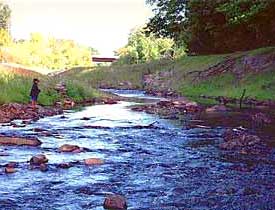 Like many Central Maine streams, Messalonskee has suffered from severe water pollution that it is now only beginning to recover from. Until the early 1990s, pollution discharges from a woolen mill and residential treated sewage caused the stream to fail to meet minimum state standards for dissolved oxygen. Agricultural and other sources of non-point pollution contribute to lowered water quality as well. The impoundment of most of the river by dams exacerbates the pollution by drastically slowing the stream’s natural flow. Events in recent months have given hope that the health of Messalonskee stream in the next century may improve markedly over its health in the past century.
Like many Central Maine streams, Messalonskee has suffered from severe water pollution that it is now only beginning to recover from. Until the early 1990s, pollution discharges from a woolen mill and residential treated sewage caused the stream to fail to meet minimum state standards for dissolved oxygen. Agricultural and other sources of non-point pollution contribute to lowered water quality as well. The impoundment of most of the river by dams exacerbates the pollution by drastically slowing the stream’s natural flow. Events in recent months have given hope that the health of Messalonskee stream in the next century may improve markedly over its health in the past century.
Re-licensing of the stream’s dams by the Federal Energy Regulatory Commission has forced the Rice’s Rips dam owner to keep a constant flow of water through the stream bed that was dry for many decades. Local efforts have begun to address non-point pollution in Fish Brook, a major tributary of Messalonskee Stream in Oakland and Fairfield.
The removal of the Edwards Dam in 1999 in Augusta has reconnected the lowermost mile of Messalonskee Stream to the ocean. Last fall, several Kennebec Atlantic salmon were found to have spawned in lower Messalonskee Stream for the first time in many many years.
In the summer of 2001 a portion of the Union Gas dam, the lowermost hydro-electric dam on the stream collapsed. Soon after, the dam’s owner, Florida Power & Light, drained the dam’s impoundment in Waterville for safety reasons. In September, the company announced that it was removing the center portion of the dam this fall for safety reasons. The company said it has yet to decide if the dam will be rebuilt next year.
The Future: Messalonskee Stream flows through one of the most populous sections of Maine. Its banks pass a remarkable variety of landscapes, from residential homes, pastures and fields, a deep and narrow gorge, the neighborhoods of Waterville and a remarkably scenic junction with the Kennebec at a long rapids called Petty’s Rips.
Across the United States, communities are recognizing the value of streams that flow through their backyards. Streams that once were severely polluted and considered eyesores are now being viewed as ideal sites for riverside parks, nature trails, fishing, canoeing and wildlife habitat. Messalonskee still bears numerous scars of abuse and neglect. Household trash, tires and other debris litter its bank and bottom in many places. The stream’s dams still impound about two thirds of the stream’s length. The State of Maine’s failure to prescribe appropriate minimum flows at the stream’s dams during the dam’s recent relicensing contribute to impaired water quality.
However, seeds of recovery have begun to take root in Messalonskee. The value of this stream
will ultimately depend on how much we value it.
